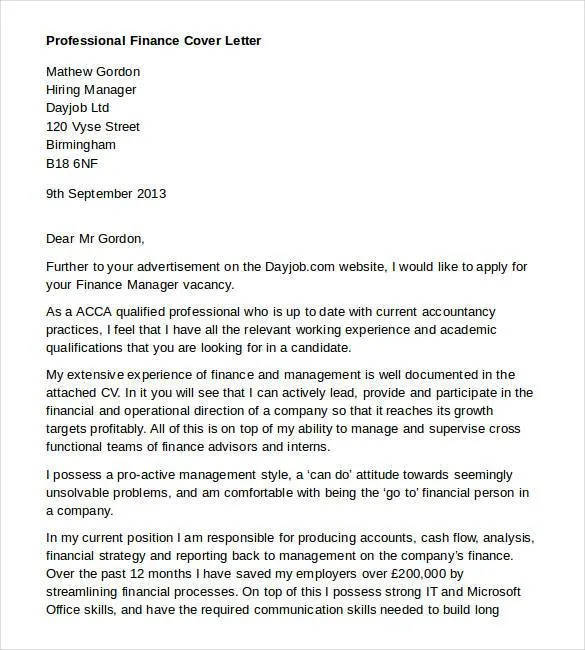Understanding the Importance of a Finance Cover Letter
In the competitive world of finance, a well-crafted cover letter can be the key that unlocks your dream job. It’s not just a formality; it’s your first opportunity to make a lasting impression on potential employers. Unlike your resume, which provides a static overview of your experience, a cover letter allows you to showcase your personality, explain your career aspirations, and highlight why you are the perfect fit for the specific role and company. This guide will provide you with the essential steps and insights needed to create a finance cover letter that not only grabs attention but also sets you apart from the competition. Remember, in finance, attention to detail is paramount, and your cover letter is a testament to your commitment to excellence.
Why a Finance Cover Letter Matters
A finance cover letter is your personal introduction to a potential employer, offering a glimpse into your character and motivations beyond the facts and figures of your resume. It allows you to connect with the hiring manager on a more personal level, demonstrating your genuine interest in the position and the company. Finance professionals are expected to possess strong communication skills, and the cover letter is your chance to prove you have them. A well-written cover letter can highlight your understanding of the industry, showcase your analytical abilities, and articulate your career goals, making it an indispensable tool in your job search. The finance sector values candidates who are proactive, communicative, and capable of presenting a compelling case for their candidacy. This is your chance to do just that.
Cover Letter vs. Resume
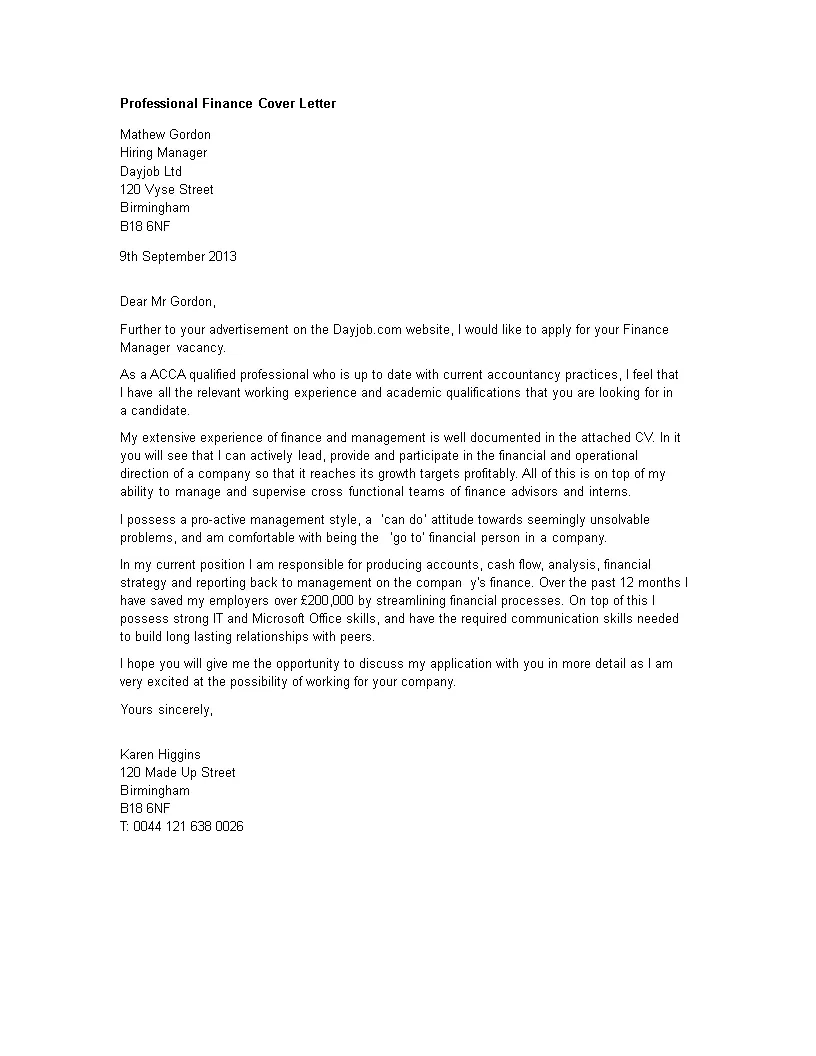
While your resume is a factual summary of your qualifications, the cover letter serves as a narrative, explaining your suitability for a specific role. Think of your resume as a reference document and your cover letter as a persuasive argument. Your resume lists your skills, experience, and education, while your cover letter explains how those elements align with the job requirements and your career aspirations. The resume is a snapshot; the cover letter is a story. The cover letter provides context, allowing you to elaborate on your achievements, demonstrate your passion for the field, and tailor your application to the specific needs of the employer. It’s the perfect opportunity to add personality and demonstrate your communication skills, which are critical in any finance role.
Key Components of a Powerful Finance Cover Letter
Contact Information & Date
Start your cover letter with your contact information, including your name, phone number, email address, and optionally, your LinkedIn profile URL. Place this information at the top of the letter, typically aligned to the left or right. Below your contact details, add the date of the letter. Next, include the hiring manager’s name and title, if available, and the company’s address. Always ensure this information is accurate and up-to-date. This section sets a professional tone and allows the recipient to quickly identify you and know when the letter was written. Accuracy and professionalism are key; taking this step right demonstrates you have already paid attention to detail, a critical trait in finance.
Greeting
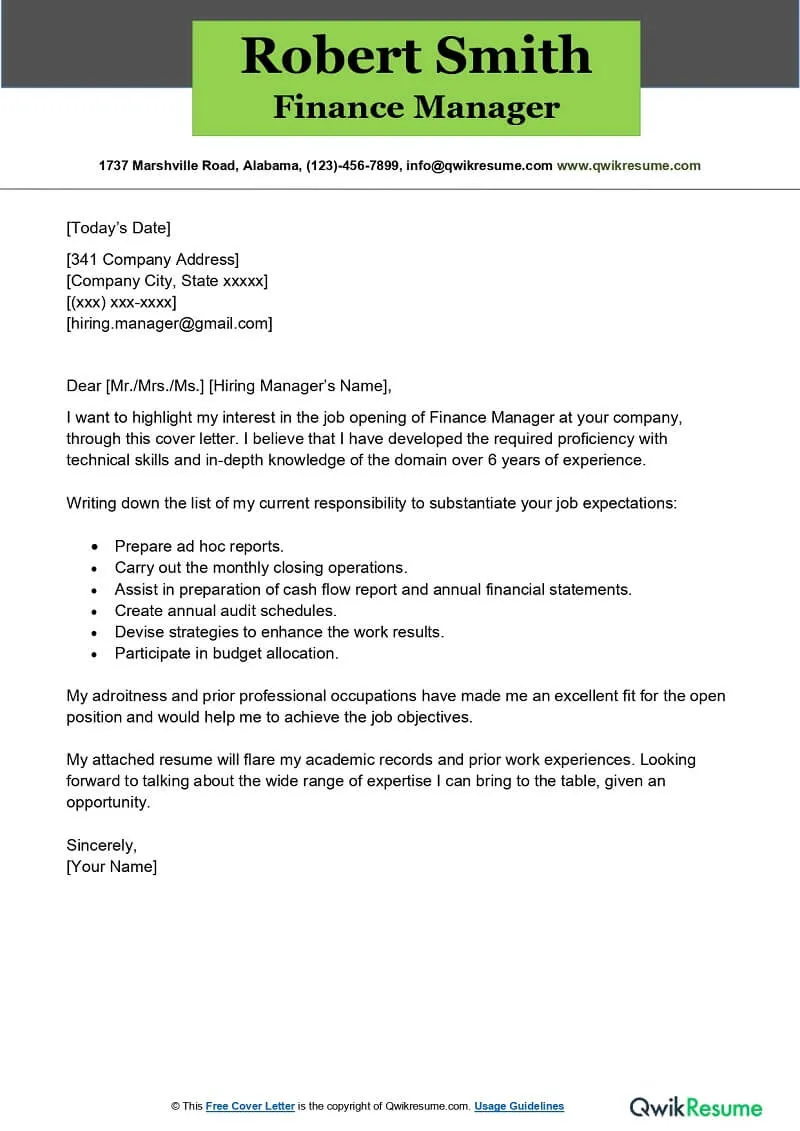
The greeting should be professional and personalized. If you know the hiring manager’s name, use it to address them directly (e.g., “Dear Mr. Smith”). This shows you’ve taken the time to research and personalize your application, which makes a positive impression. If the hiring manager’s name is not available, use a general greeting like “Dear Hiring Manager” or “Dear [Company Name] Hiring Team.” Avoid generic greetings like “To Whom It May Concern,” as they come across as impersonal. The greeting is the first communication with the reader, setting the tone and inviting them to continue reading. It is crucial to make a positive first impression.
Opening Paragraph
Your opening paragraph is your first chance to grab the reader’s attention. State the position you’re applying for and where you saw the job posting. Briefly mention something specific that attracted you to the role or the company. Make it clear why you’re interested and how your skills align with the company’s needs. This paragraph should be concise, engaging, and demonstrate your enthusiasm. It should immediately capture the reader’s interest and encourage them to continue reading. A strong opening paragraph sets the stage for the rest of your cover letter, making it clear that you understand the role and are prepared to contribute.
Highlighting Your Skills and Experience
In the main body of your cover letter, highlight the skills and experiences most relevant to the job description. Instead of simply listing your qualifications, explain how your skills and experiences have helped you achieve tangible results in the past. Use the STAR method (Situation, Task, Action, Result) to structure your responses and provide concrete examples of your accomplishments. For each skill or experience you highlight, explain its relevance to the job and how it aligns with the company’s needs. This section should demonstrate that you have the skills, experience, and knowledge required to excel in the position.
Quantifying Your Achievements
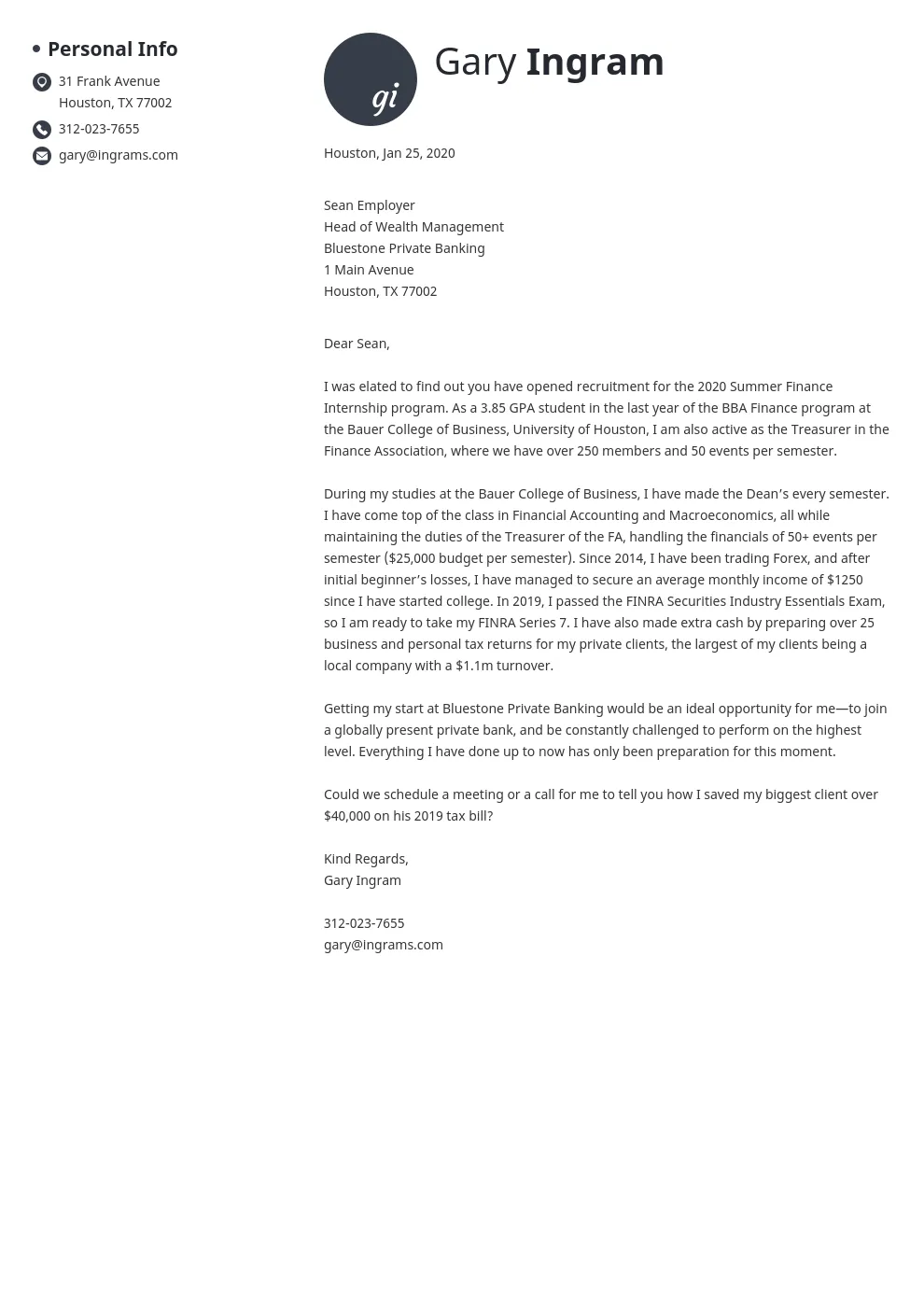
Wherever possible, quantify your achievements with numbers and data. Instead of saying “Improved efficiency,” say “Improved operational efficiency by 15% through process optimization.” Quantifiable results are more impactful and demonstrate the value you bring to the table. Use metrics like revenue growth, cost savings, and project completion rates to showcase your achievements. Quantifiable achievements give the reader concrete evidence of your success, making your application much more compelling. In finance, data-driven results speak volumes and make it easier for the hiring manager to see the impact you can make.
Tailoring Your Cover Letter
Customize your cover letter for each job application. Research the company and the specific role, and tailor your letter to address the specific requirements and keywords mentioned in the job description. Show the hiring manager that you understand the company’s mission, values, and culture. Include examples that demonstrate your understanding of the industry and the challenges faced by the company. Tailoring your cover letter shows that you have invested time and effort into the application, demonstrating your interest in the position. Generic cover letters will likely be overlooked; however, a tailored one will resonate with the reader and significantly increase your chances of securing an interview.
Demonstrating Your Passion
A finance cover letter that truly stands out showcases your passion for the field. Express your genuine interest in finance and the specific role you are applying for. Share why you are drawn to the industry, the company, and the position. This might include your interest in financial modeling, market analysis, or investment strategies. Explain how your career goals align with the company’s objectives. Demonstrating your passion shows that you are not just seeking a job, but a career. This enthusiasm can set you apart from other candidates, making a strong impression on the hiring manager. Your passion can be shown through examples of past projects, industry research, or volunteer work.
Expressing Enthusiasm for the Role
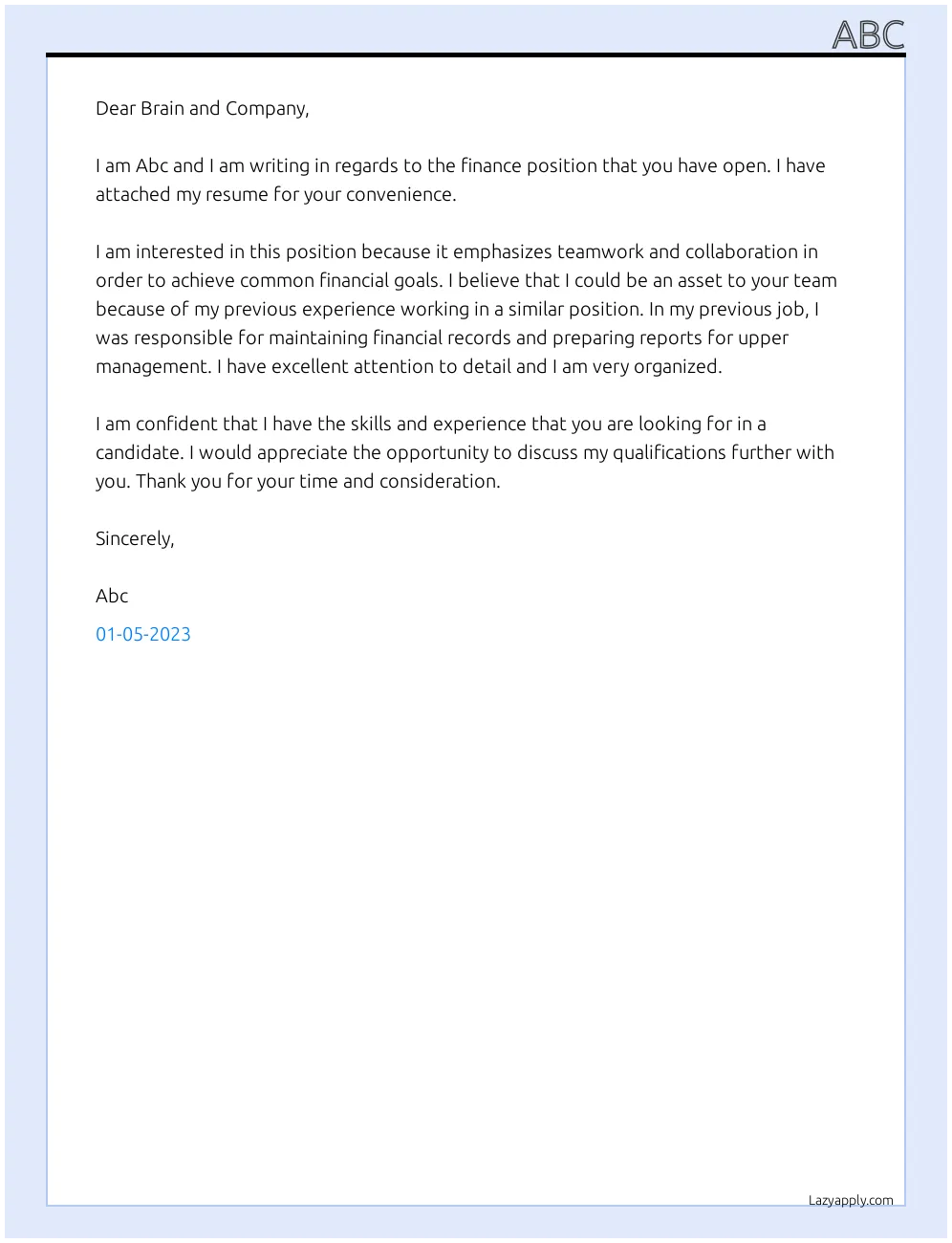
Expressing enthusiasm for the role is vital. Demonstrate your eagerness to contribute to the company’s success. Explain why you are excited about the opportunity and what you hope to achieve. Mention specific projects or initiatives you would like to be involved in. Your enthusiasm should be genuine and professional, not over the top. This can include showing you have looked over the company’s financials and know their current projects. Expressing enthusiasm in a finance cover letter can make a difference in a competitive market. It is your chance to show you’re more than just a resume; you are a person excited for the chance.
Closing Paragraph
In your closing paragraph, reiterate your interest in the position and thank the hiring manager for their time and consideration. Reiterate your enthusiasm and confidence in your ability to contribute to the company. Briefly summarize your key qualifications, and include a call to action, inviting the hiring manager to contact you for an interview. This closing should leave a lasting positive impression and encourage the hiring manager to take the next step.
Call to Action
Include a clear and concise call to action. Invite the hiring manager to contact you for an interview or to discuss your qualifications further. Make it easy for them to take the next step in the hiring process. Provide your contact information again to make sure they can easily reach you. A strong call to action encourages them to move forward. End your cover letter confidently, reinforcing your interest and ensuring they remember you.
Formatting and Design Best Practices
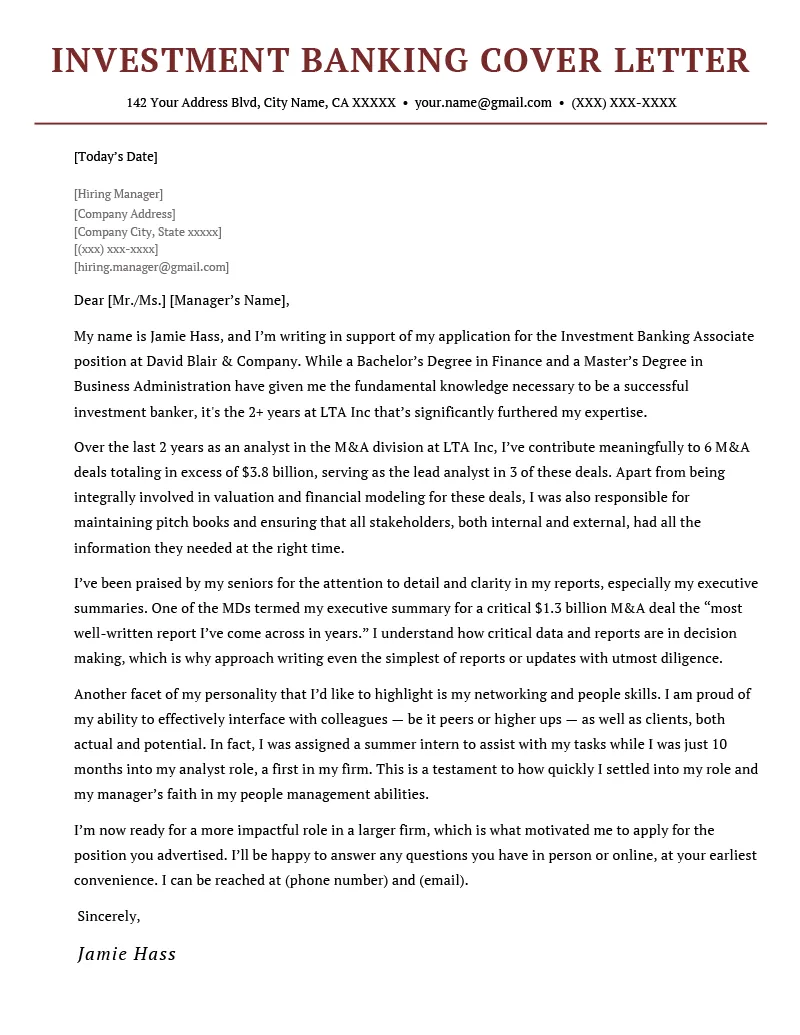
The formatting and design of your cover letter are critical to creating a positive first impression. A well-formatted cover letter is easy to read and visually appealing, demonstrating your attention to detail and professionalism. The appearance of your cover letter must be impeccable. Choose a font and design that looks professional. Ensure there are no errors in grammar or presentation. Your application will be judged by these standards. It is all part of a process that will ensure you land your dream job.
Choosing the Right Font
Select a professional and easy-to-read font, such as Times New Roman, Arial, Calibri, or Helvetica. Use a font size between 10 and 12 points. Avoid using overly decorative or unusual fonts. A clean, readable font ensures that the hiring manager can easily scan your cover letter. These are all part of your ability to present professional documents that follow established standards. Clarity and readability are essential in a finance-related document. Choose a font that does not distract from the content of your cover letter.
Formatting Guidelines
Use consistent formatting throughout your cover letter. Align text to the left, use single or 1.15 line spacing, and include a margin of at least one inch on all sides. Use appropriate spacing between paragraphs and sections to improve readability. Ensure proper spacing and formatting create a visually appealing document. Maintain consistent formatting throughout your letter. This ensures the reader can focus on your content and gives you a professional advantage. Good formatting shows attention to detail, which is valued in the finance industry.
Proofreading and Editing Your Cover Letter
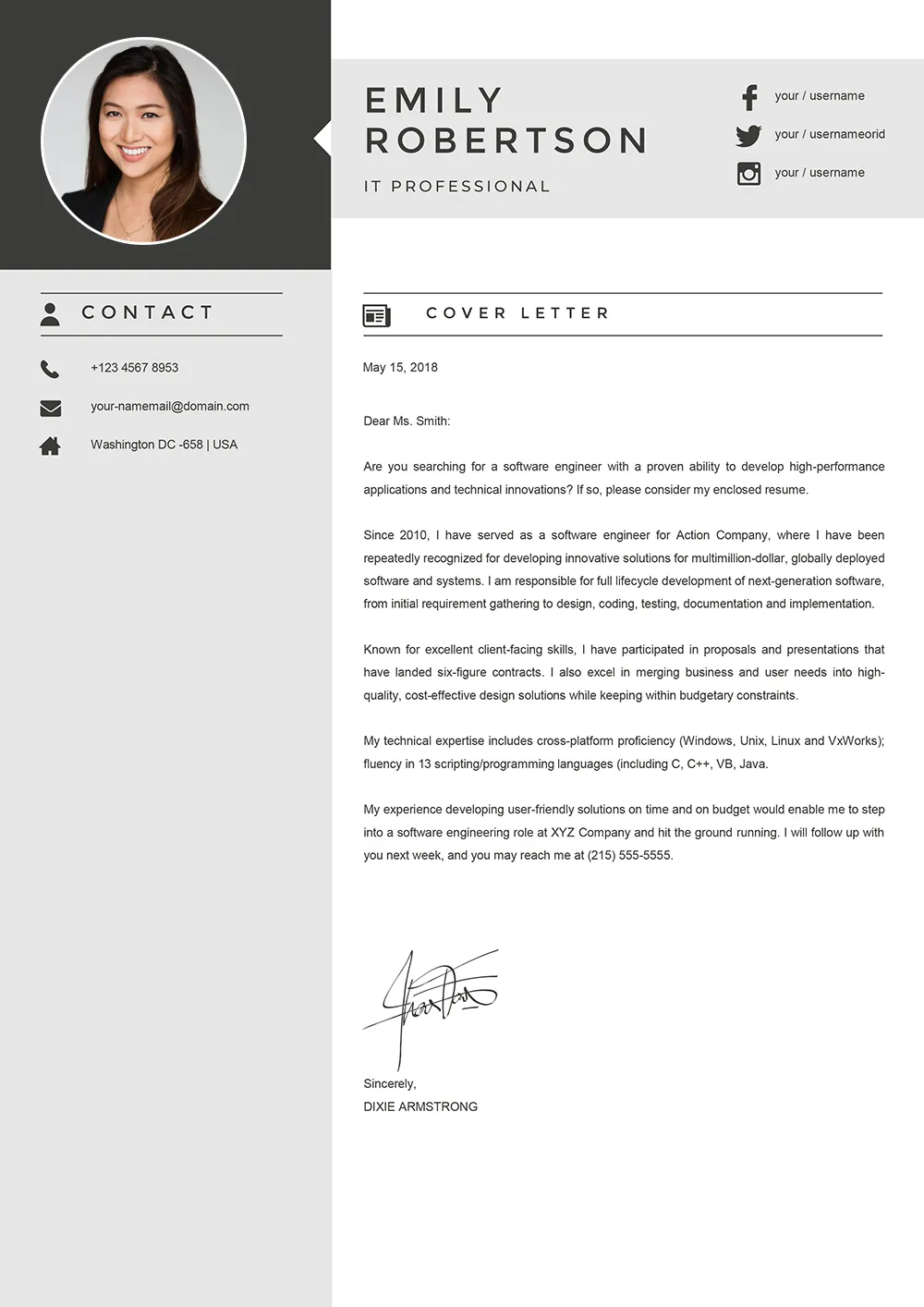
Proofreading and editing are crucial steps in preparing your finance cover letter. Errors in grammar, spelling, and punctuation can damage your credibility and may lead to your application being rejected. Always proofread your cover letter carefully for any mistakes. Use a spell checker and grammar checker, but also read the letter aloud to catch any errors that software may miss. Ask a friend, colleague, or career advisor to review your cover letter and provide feedback. Having a second pair of eyes can help you identify any areas for improvement. A polished, error-free cover letter shows your attention to detail. This is an important aspect of the finance world.
Common Mistakes to Avoid in Your Finance Cover Letter
Avoid these common mistakes to ensure your finance cover letter stands out for the right reasons. These mistakes can create negative impressions. They can even lead to immediate rejection from consideration. By avoiding these pitfalls, you will have a much better chance of securing an interview. Taking time to review and eliminate these mistakes will ensure your letter aligns with best practices.
Using Generic Language
Avoid using generic, clichéd phrases that do not provide any specific information about your skills and experience. Instead, use specific examples to demonstrate your capabilities. Generic language shows a lack of effort. Avoid phrases such as “hard-working,” “team player,” or “results-oriented” without providing any evidence to support these claims. Use action verbs and provide quantifiable results to show that you are a valuable asset to the company. The finance world expects candidates to demonstrate real-world results. Be specific and direct.
Typos and Grammatical Errors
Typos and grammatical errors can immediately undermine your credibility. Always proofread your cover letter carefully. Use spell-check and grammar-check tools. It’s important to have someone else review your cover letter before submitting it. Mistakes show a lack of attention to detail. A cover letter is your first chance to show you pay attention to detail, which is critical in finance. Reviewing and removing errors will improve your chances of a positive reception and interview.
Failing to Tailor Your Letter
A generic cover letter that is not tailored to the specific job and company will likely be disregarded. Always research the company and the position. Customize your cover letter to highlight the skills and experiences most relevant to the job. Make sure the letter explains why you are a good fit for the role and the company. Generic cover letters demonstrate that the candidate has not taken the time to understand the company’s needs and requirements. Personalization shows that you have genuine interest in the role. Generic letters often go unread; therefore, it is important to tailor your cover letter. Tailoring your letter may make the difference between an interview offer or rejection.
Finance Cover Letter Examples
Reviewing finance cover letter examples can provide valuable insights into how to structure and write your own. Look for examples tailored to specific roles within the finance industry. Analyze how these samples highlight key skills, quantify achievements, and demonstrate a genuine interest in the company. Use these examples as a guide. Always tailor them to your specific situation and the job you are applying for. Studying finance cover letter examples is a good way to develop an effective approach. Remember that personalization is key. Do not simply copy samples; adapt and customize the content to reflect your unique skills and experience.
